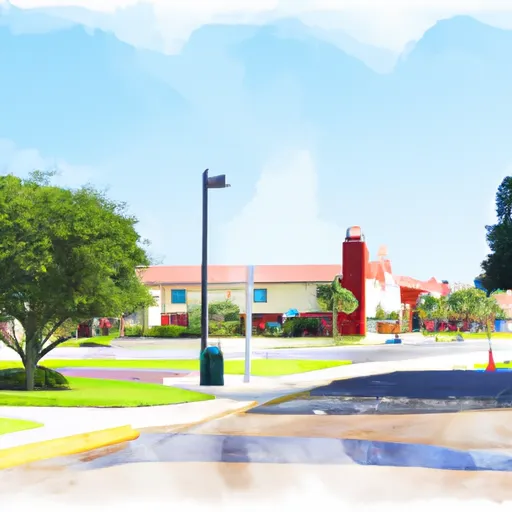-
 Snoflo Premium
Snoflo Premium
Get unlimited access to all our content
With no Ad interruptions! - Start Your Free Trial Login with existing account
Meadows-Village
Eden Index
Climate
6.5
•
Recreation
7.3
•
Community
2.5
•
Safeguard
5.8/10

Meadows-Village, Florida is a charming town located in the southern part of the state. The climate in Meadows-Village is typically warm and tropical, with hot and humid summers and mild winters. The town experiences abundant sunshine throughout the year, making it an ideal destination for outdoor enthusiasts.
Hydrologically, Meadows-Village is blessed with several lakes and rivers. The town is situated near the Kissimmee River, which provides opportunities for fishing, boating, and other water-based activities. Additionally, the area boasts numerous natural springs, such as Blue Spring and Silver Springs, which offer opportunities for swimming, snorkeling, and cave diving.
Outdoor recreation opportunities in Meadows-Village are diverse and plentiful. The town is surrounded by lush greenery, offering opportunities for hiking, biking, and wildlife viewing. The nearby Ocala National Forest provides ample opportunities for camping, hunting, and horseback riding. Golf enthusiasts can enjoy several well-maintained golf courses in and around town.
Overall, Meadows-Village, Florida offers a favorable climate, beautiful hydrological features, and a wide range of outdoor recreation opportunities, making it an attractive destination for nature lovers and adventure seekers.
What is the Eden Index?
The Snoflo Eden Index serves as a comprehensive rating system for regions, evaluating their desirability through a holistic assessment of climate health, outdoor recreation opportunities, and natural disaster risk, acknowledging the profound impact of these factors on livability and well-being.
Climate Health Indicator (CHI): 6.5
Meadows-Village receives approximately
1379mm of rain per year,
with humidity levels near 87%
and air temperatures averaging around
23°C.
Meadows-Village has a plant hardyness factor of
9, meaning
plants and agriculture in this region tend to thrive here all year round.
By considering the ideal temperature range, reliable water supplies, clean air, and stable seasonal rain or snowpacks, the Climate Health Indicator (CHI) underscores the significance of a healthy climate as the foundation for quality living.
A healthy climate is paramount for ensuring a high quality of life and livability in a region, fostering both physical well-being and environmental harmony. This can be characterized by ideal temperatures, reliable access to water supplies, clean air, and consistent seasonal rain or snowpacks.
Weather Forecast
Streamflow Conditions
Tampa Bay
Area Rivers
Tampa Bay
Snowpack Depths
Tampa Bay
Reservoir Storage Capacity
Tampa Bay
Groundwater Levels
Recreational Opportunity Index (ROI): 7.3
The Recreational Opportunity Index (ROI) recognizes the value of outdoor recreational options, such as parks, hiking trails, camping sites, and fishing spots, while acknowledging that climate plays a pivotal role in ensuring the comfort and consistency of these experiences.
Access to outdoor recreational opportunities, encompassing activities such as parks, hiking, camping, and fishing, is crucial for overall well-being, and the climate plays a pivotal role in enabling and enhancing these experiences, ensuring that individuals can engage in nature-based activities comfortably and consistently.
Camping Areas
| Campground | Campsites | Reservations | Toilets | Showers | Elevation |
|---|---|---|---|---|---|
| Fort Desoto County Park | 238 | 3 ft | |||
| Coons Creek Military - MacDill AFB | None | 5 ft | |||
| Lake Manatee State Park | None | 68 ft | |||
| Oscar Scherer State Park | None | 6 ft | |||
| Raccoon Creek Military - MacDill AFB | None | 5 ft | |||
| Little Manatee River State Park | None | 21 ft | |||
| Holder Mine - Withlacoochee State Forest | 13 | 34 ft | |||
| E G Simmons County Park | None | 7 ft |
Catastrophe Safeguard Index (CSI):
The Catastrophe Safeguard Index (CSI) recognizes that natural disaster risk, encompassing floods, fires, hurricanes, and tornadoes, can drastically affect safety and the overall appeal of an area.
The level of natural disaster risk in a region significantly affects safety and the overall livability, with climate change amplifying these risks by potentially increasing the frequency and intensity of events like floods, fires, hurricanes, and tornadoes, thereby posing substantial challenges to community resilience and well-being.
Community Resilience Indicator (CRI): 2.5
The Community Resilience Indicator (CRI) recognizes that education, healthcare, and socioeconomics are crucial to the well-being of a region. The CRI acknowledges the profound impact of these elements on residents' overall quality of life. By evaluating educational resources, healthcare accessibility, and economic inclusivity, the index captures the essential aspects that contribute to a thriving community, fostering resident satisfaction, equity, and social cohesion.

